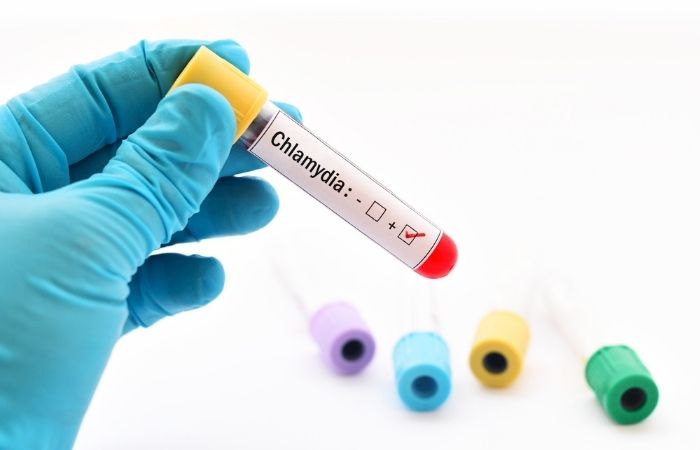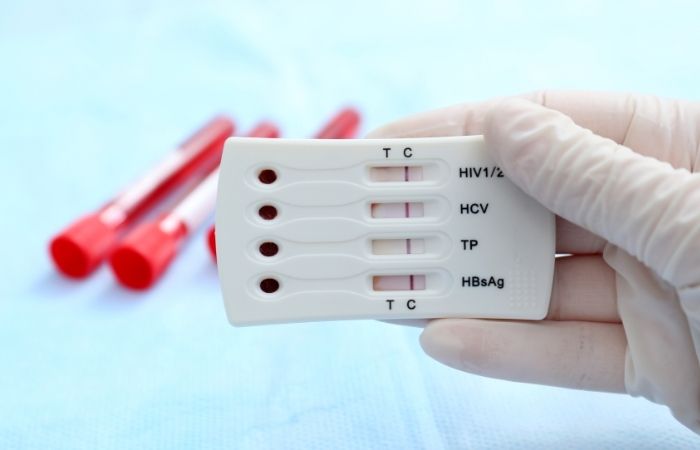Quick Answer: At-home STD test kits let you collect a urine, swab, or blood sample in private, then send it to a CLIA-certified lab, or get results instantly via a rapid test device. Most kits use highly accurate PCR or antigen/antibody methods. While lab-based tests may take several days for results, rapid kits for HIV, syphilis, or trichomoniasis can deliver answers within minutes.
What Types of Samples Do You Collect?
At-home test kits typically include one or more of the following: a urine cup (for chlamydia, gonorrhea, trichomoniasis), a genital or throat swab (similar to clinic swabs), or a finger-prick blood lancet (for HIV, syphilis, sometimes herpes or HBV). Some kits, like the newly FDA authorized Visby test, process a vaginal swab onsite via a proprietary device, returning results in about 30 minutes from home.

People are also reading: The Pleasure Panic: How STD Fear Fuels Abstinence-Only Sex Ed
Do You Run the Test or Mail It?
There are two main pathways:
- Lab‑based self‑collection: You collect your sample, seal it per instructions, and mail it to a certified lab for PCR or immunoassay testing. Results arrive via secure portal, email, or phone in 1–7 days depending on service and shipping.
- Rapid at‑home test: Some FDA-cleared devices, like Visby or home syphilis tests, include a powered reader or lateral flow device that gives results in minutes, no lab required.
How Do the Tests Actually Detect STIs?
Most lab-based tests use NAAT (nucleic acid amplification testing) like PCR, which amplifies trace amounts of bacterial (e.g. chlamydia, gonorrhea) or viral genetic material in urine or swab samples with high accuracy, often >95% sensitivity and >99% specificity. Rapid tests may use antigen-antibody detection or lateral flow immunoassays, similar to home pregnancy tests, showing visible lines if antibodies or antigens are detected in blood or fluid.
Are At‑Home STD Tests Accurate?
When used correctly, many at‑home STD tests are nearly as accurate as clinic-based versions. Lab-based kits often use the exact same technologies as medical providers, PCR for bacterial STIs like chlamydia and gonorrhea, or antigen/antibody tests for HIV and syphilis. In some studies, NAAT-based at-home tests showed sensitivities between 92–99% and specificities above 99%. That means very low rates of false positives or negatives, especially when samples are properly collected and shipped promptly.
That said, accuracy depends on several factors:
- Timing (window period): If you test too soon after exposure, the virus or bacteria may not be detectable yet.
- Sample quality: Improper swabbing, not collecting enough urine, or hemolyzed blood can impact results.
- Storage and shipping: Some kits require cold storage or quick mailing to protect sample integrity.
Rapid at‑home tests tend to be slightly less sensitive than lab-based PCR tests, but are still considered highly effective for screening and repeat testing. For example, the OraQuick In-Home HIV Test has a reported sensitivity of 92% and specificity of 99.98%.
Check Your STD Status in Minutes
Test at Home with Remedium3-in-1 STD Test Kit

 For Men & Women
For Men & Women Results in Minutes
Results in Minutes No Lab Needed
No Lab Needed Private & Discreet
Private & DiscreetOrder Now $69.00 $147.00
For all 3 tests
When Should You Use an At‑Home STD Test?
There’s no perfect timing, but there are smart guidelines. Most people test when they’ve had a new partner, had sex without a condom, or feel symptoms like discharge, burning, or sores. At-home STD kits are especially helpful if:
- You’re nervous about going to a clinic or don't want it on insurance records
- You live in a rural area or have limited transportation
- You need to retest after treatment or a past positive result
- Your partner refuses to get tested and you want to take initiative
According to the CDC, all sexually active people under 25 (especially women, trans men, and nonbinary folks with a cervix) should get tested annually for chlamydia and gonorrhea. MSM (men who have sex with men) should test every 3–6 months if sexually active, and everyone should test for HIV at least once in their life or more if at risk.
What’s the Window Period for Testing Accuracy?
A lot of people get this wrong here. The "window period" for each STD is the time between when you get it and when it shows up on a test. If you test too soon, you might get a false negative. Here's a quick summary:
- Chlamydia and gonorrhea: 5 to 7 days after exposure (urine or swab)
- HIV: 2 to 4 weeks for antigen/antibody tests, up to 90 days for full accuracy
- Syphilis: Blood antibody test 3 to 6 weeks after exposure
- Trichomoniasis: 5 to 14 days, depending on the test method
- Herpes Simplex Virus 2 (HSV-2): The antibody test is only accurate after 12 to 16 weeks.
If you test early and the results are negative, you should test again after the window period ends, especially if you have symptoms or were exposed to a high-risk situation. The general rule is? If something doesn't seem right, trust your gut and try again. Tests you can do at home make that easier than ever.
What About Privacy and Discretion?
For many people, privacy is the entire reason they choose at-home STD kits. These tests are delivered in discreet packaging, no brand names, no “STD” or “sexual health” labels, and often just a generic return address. Inside, the contents are clearly labeled with step-by-step instructions, but nothing that would reveal sensitive health info at a glance.
Some companies even offer:
- Amazon Locker delivery for added anonymity
- Text-only results so no emails pop up
- HIPAA-compliant platforms with secure logins
If you live with family or a partner and need to keep things completely private, consider choosing a kit with digital-only tracking and results. Most services allow you to use a preferred name and email, and avoid anything that might show up on insurance statements (known as an EOB).

People are also reading: The Breakthrough HIV Injection You Need to Know About
What Happens After You Get Results?
One of the biggest fears people have is “What if I test positive?” Good news: most companies that sell at-home STD kits include free consultations with licensed doctors or nurses if your results come back positive. They’ll explain the result, offer prescriptions if needed (like doxycycline or azithromycin), and can even call in treatment to your local pharmacy.
What usually happens is this:
- Negative result: You don't have any of the infections that were tested. Retest after 3 to 6 months or after new exposures.
- Positive result: You get a call, a secure message, or an email with the next steps. You can upload your results to a telehealth app or book treatment right away with some services.
- If the result is not clear, you will be told to retest or go to a clinic for follow-up.
This system works well for a lot of common STDs. But if you need treatment for a more serious condition, like HIV or advanced syphilis, your at-home provider will send you to a local specialist or free clinic for tests to confirm the diagnosis and full care.
Who Are the Best At‑Home STD Test Providers?
It all depends on what you want: speed, cost, privacy, or full-spectrum care. Here is a list of some of the best options:
- STD Rapid Test Kits: These kits let you do quick, FDA-approved home tests for HIV, syphilis, herpes, and other STDs. They come in discreet packaging and give you clear results.
- LetsGetChecked: Provides lab-based testing with prepaid mailers and follow-up from a nurse for positive results.
- Everlywell is known for its easy-to-use kits and wide availability in stores.
- myLAB Box: Great for combo kits that test for more than one STD at a time, like oral, anal, and genital swabs.
- Visby Medical: The first home test for three STIs that the FDA has approved. Results come in 30 minutes.
If you're testing multiple body parts or are worried about having to do it again, make sure to pick a provider that meets your needs. If you want to be 100% sure about your status, you can always call a clinic again. There's no shame in doing that.
Testing by Body Site: Why It Matters
Not all partners or exposures are the same, and neither are the optimal testing sites. At-home kits often let you choose, but knowing what to pick matters:
- Throat (pharyngeal) swabs: Used to find gonorrhea or chlamydia from oral sex. A lot of people don't know that throat infections are common and don't show any symptoms, but they can spread to other people.
- Rectal swabs are a must for anyone who has anal sex. Chlamydia and gonorrhea can stay in rectal tissue without causing any symptoms, which could lead to problems later or spread of the disease.
- Swabs from the vagina or penis or urine: This is the usual way to test for chlamydia, gonorrhea, and trichomoniasis. Tests that only look at urine might miss exposure in the throat or rectum.
- Finger prick blood test: used to check for HIV, syphilis, herpes, and hepatitis. These tests look for antibodies instead of live infections, so you might have to wait longer after being exposed.Choosing the wrong site isn’t just inconvenient, it can lead to false negatives or missed infections, delaying diagnosis and treatment.
Check Your STD Status in Minutes
Test at Home with Remedium10-in-1 STD Test Kit

 For Women
For Women Results in Minutes
Results in Minutes No Lab Needed
No Lab Needed Private & Discreet
Private & DiscreetOrder Now $189.00 $490.00
For all 10 tests
When to Repeat or Retest: Windows, Follow-up & Confirmation
Timing isn’t a one-time decision, it’s a process. Many infections may not be detected until days or weeks post-exposure. If a test is taken too early, it can return as negative even if infection is already underway. That’s why some kits recommend follow-up testing if initial results are negative but exposure continues or symptoms appear.
For example, HIV requires testing at 45–90 days for high-accuracy antibody results, while syphilis testing is most reliable after 3–6 weeks. If an at-home test is inconclusive, or shows a faint line, it’s advisable to confirm via a clinic-based assay. Don’t accept uncertainty. Double-checking early saves long-term consequences.
Insurance, Regulation & Consumer Rights
At-home STD tests are regulated by the FDA or designated as CLIA-waived devices depending on the technology. That means manufacturers must meet certain accuracy and user-safety standards. Also, each state’s telehealth regulations may affect lab follow-up or telemedicine consultations.
It can be scary to pay out of pocket, but many kits cost between $90 and $200, which is much less than a whole clinic visit, lab fees, or follow-up visits. Some HSA/FSA plans will pay you back for your purchase. If your results are positive, labs or test providers can often help you file an insurance claim for confirmatory testing or treatment, especially for HIV or syphilis.
How to Stay Grounded While You Wait to Lower Your Anxiety
It can be very stressful to wait for test results. Here's how to deal with it in a positive way:
- Keep an eye on your timeline: Note down the date you collected the sample, the estimated time it will arrive at the lab, and the date you expect to get the results.
- Avoid symptom scanning: It’s common to look for any scratch or tingle, but those are almost always unrelated or psychosomatic. Focus on objective symptoms like discharge, sores, or burn when needed.
- Plan an activity: Line up a distraction, a walk, book, or favorite show, to keep your mind off “waiting” mode.
- Use trusted support: Talk to someone you trust or a peer support group. You're not alone; many people test regularly and feel nervous about it too.
A test doesn't define who you are. It's only one piece of information. No matter what the results are, you still get to choose what happens next.

People are also reading: The Most Common Sexually Transmitted Diseases and How They Spread
FAQs
1. Do STD tests you do at home really work?
Yes, especially kits that are based in labs. Most of them use PCR or antigen/antibody methods, which are 90–99% accurate if done correctly and at the right time.
2. Is it possible to use insurance for tests done at home?
Most kits don't have insurance, but that also means they're private and you don't have to explain them on your EOB. Some HSA/FSA accounts will pay for the cost.
3. What if I get a positive test?
You usually get a free consultation and treatment plan. A prescription is all you need for most infections, such as chlamydia, gonorrhea, or trichomoniasis.
4. Is it possible to test for all STDs at home?
Yes, you can test for HIV, syphilis, herpes, HPV, and more. Just make sure you pick the right body site and the right time frame after exposure.
5. How long does it take to get results?
Tests that are quick give results in minutes. It takes 2 to 5 business days for lab-based kits to work after your sample gets to the lab.
6. Are these kits legal to use?
Yes. Depending on the provider, at-home STD tests are legal and have been approved by the FDA or CLIA.
7. What if my sample goes missing?
Most delivery services keep track of packages. They'll send you a free replacement if you lose it. Some services come with prepaid labels that have tracking numbers.
8. Will my partner find out that I got tested?
If you tell them, yes. Kits for use at home don't share information with partners or insurance companies. Everything stays between you and the provider.
9. Which test is the best one to start with?
Most people do best with a 4- or 6-panel test. It talks about the most common STDs, like HIV, chlamydia, gonorrhea, and syphilis.
10. Are these kits okay for LGBTQ+ people?
Of course. Many at-home testing services let you test your anus, throat, and genitals, which is great for queer and trans people.
Conclusion: At‑Home Testing Is Changing the Game
Whether you're dealing with shame, distance, fear, or a jam-packed schedule, at-home STD testing puts the power back in your hands. These kits let you make smart, proactive decisions about your sexual health without waiting in clinic lines, risking exposure, or dealing with awkward conversations at reception desks. They're not perfect, but they're private, accessible, and lifesaving for millions of people every year.
Being sexually active means taking responsibility for your body, and that includes testing. Whether it’s every 3 months or once a year, the sooner you start using these tools, the easier it gets. You deserve to know what’s going on, quietly, quickly, and without shame.
STD Rapid Test Kits provides discreet, fast, and accurate at-home STD kits you can trust. Take charge of your health, your peace of mind is worth it.
Sources
1. Healthline – How Do STD Tests Work?
2. Cleveland Clinic – How STI Testing Works
3. Self – Do At-Home STI Tests Work?










